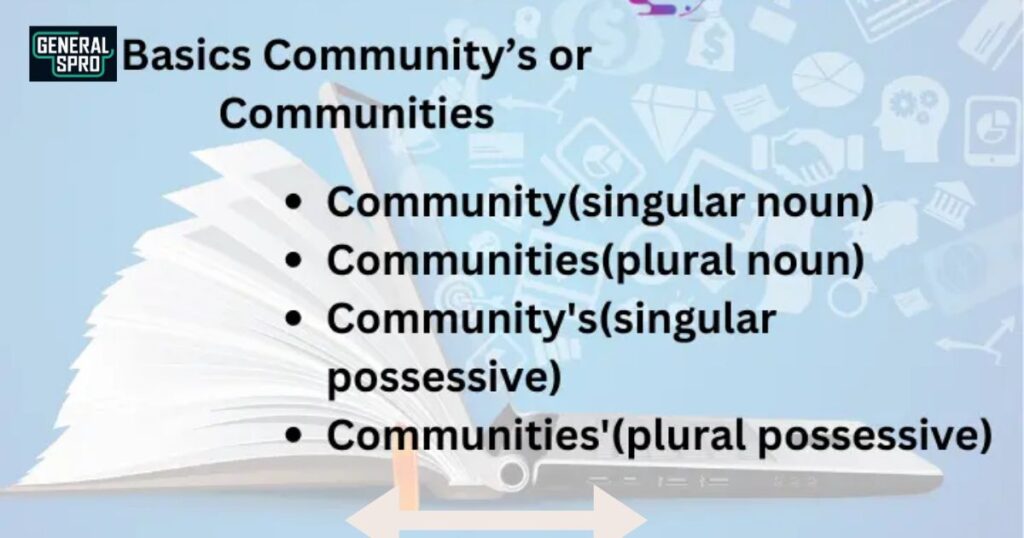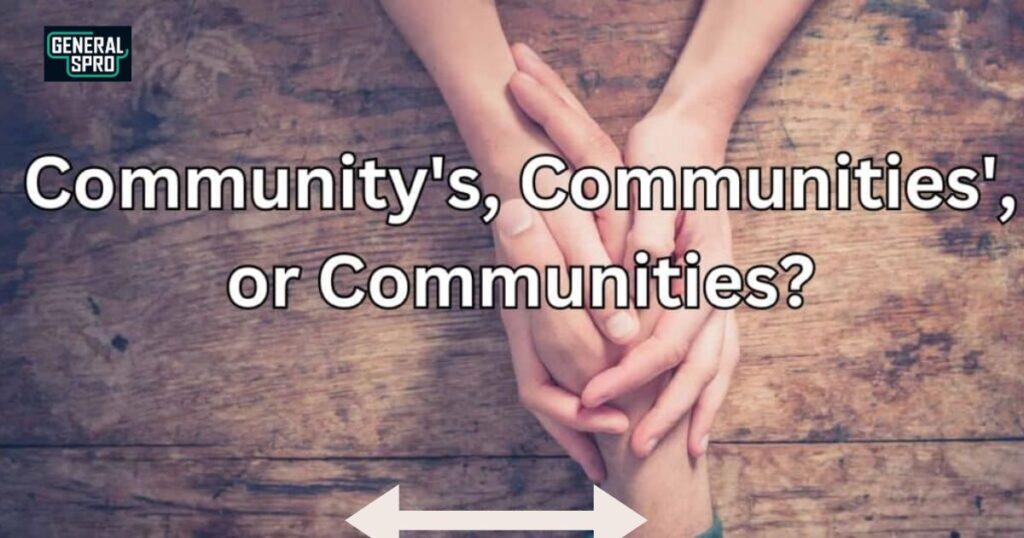Understanding when to use “community’s,” “communities’,” or “communities” can challenge even experienced writers. This comprehensive guide will help you master these distinctions and use them correctly every time.
Whether you’re writing a business report, academic paper, or casual email, knowing the proper usage of these terms will enhance your credibility and clarity.
The Basics: Community’s, Communities’, or Communities?

Before diving into specific examples, let’s establish the fundamental differences between these three forms. Each serves a distinct grammatical purpose, and understanding these core differences will help you make the right choice in your writing.
The key lies in determining whether you’re dealing with a single community or multiple communities, and whether you’re showing possession.
Community’s (Singular Possessive)
The form “community’s” indicates that something belongs to or is associated with a single community. This follows the basic English rule for creating singular possessive nouns: add an apostrophe and ‘s’ to show ownership.
When you’re referring to one community that possesses something, “community’s” is your go-to choice.
More Examples:
Consider these practical applications:
- The community’s garden received an award for sustainability
- Our community’s decision-making process involves monthly town halls
- The local community’s response to the crisis was remarkable
- Each community’s unique characteristics contribute to its identity
Communities (Plural Form)
The term “communities” simply refers to more than one community. It’s the standard plural form, created by adding “es” to the singular noun “community.”
This form doesn’t show possession – it merely indicates multiple communities. Understanding this basic plural form is essential before tackling the plural possessive.
More Examples:
In professional and academic contexts, you might encounter these applications: “Rural and urban communities often face different challenges in economic development.” “Diverse communities strengthen our social fabric.” “Online communities continue to reshape how people connect.”
Communities’ (Plural Possessive)
When multiple communities possess something collectively, we use “communities'” – the plural possessive form.
This construction places the apostrophe after the ‘s’ to indicate plural ownership. It’s crucial to distinguish this from the singular possessive form, as they serve different grammatical purposes.
More Examples:
Here are some contexts where you’d use the plural possessive: “The neighboring communities’ shared resources benefit everyone.”
“All three communities’ efforts resulted in successful flood prevention.” “The coastal communities’ fishing rights were protected by new legislation.”
Common Mistakes and How to Avoid Them
A frequent error occurs when writers use the plural form instead of the singular possessive. For example: Incorrect: “The communities recycling program won an award.” Correct: “The community’s recycling program won an award.”
Mistake 2: Using Community’s for Multiple Communities
Another common mistake involves using the singular possessive when referring to multiple communities: Incorrect: “The five community’s representatives met last week.” Correct: “The five communities’ representatives met last week.”
How to Remember the Differences
To consistently use these forms correctly, follow this simple decision tree:
- Are you talking about one community or multiple communities?
- Are you showing possession?
- If it’s one community showing possession: use community’s
- If it’s multiple communities showing possession: use communities’
- If it’s multiple communities with no possession: use communities
Practice Makes Perfect
Test your understanding with these examples:
- Single community with possession: “The community’s playground needs repairs.”
- Multiple communities without possession: “These communities share similar values.”
- Multiple communities with possession: “The communities’ joint initiative succeeded.”
Understanding the Evolution of Community Grammar
The English language’s treatment of community-related terms has evolved significantly over centuries. Modern usage rules emerged from historical patterns of showing possession and plurality in written communication.
This evolution reflects how communities themselves have changed, from simple geographic groupings to complex social structures including both physical and virtual spaces.
Digital Age Impact on Community Terms

In today’s digital landscape, proper usage of community-related terms has become increasingly important.
Social media managers, content creators, and online community administrators must navigate these grammatical distinctions when writing about virtual communities, making clear communication more crucial than ever.
Professional Applications in Business Writing
Business communications require precise language usage, particularly when discussing community engagement.
Whether writing reports, proposals, or marketing materials, understanding the correct form enhances professional credibility and ensures clear message delivery to stakeholders.
Academic Research and Community Studies
Scholarly writing about communities demands meticulous attention to grammatical accuracy. Researchers frequently discuss multiple communities and their collective characteristics, making mastery of these terms essential for academic integrity and clarity.
Legal Documentation and Community Rights
Legal documents must maintain absolute precision when referring to community ownership and rights. The distinction between singular and plural possession can have significant legal implications, affecting everything from property rights to governance structures.
Journalistic Standards for Community Coverage
Media professionals face unique challenges when reporting on community affairs. Accurate usage of these terms ensures precise reporting and helps avoid misrepresentation of community ownership or involvement in news stories.
Cultural Considerations in Community Terms
Different cultures may approach community ownership and plurality in varying ways. Understanding these variations helps writers communicate effectively across cultural boundaries while maintaining grammatical accuracy.
Social Media and Community Management
Community managers must navigate these grammatical distinctions when creating social media content. Clear communication about community guidelines, events, and policies requires consistent and accurate usage of these terms.
Educational Materials and Teaching Methods
Teachers and educational content creators need to effectively explain these concepts to students. Developing clear, engaging materials helps learners master these grammatical distinctions through practical examples and exercises.
Government Documentation Requirements
Official government documents require strict adherence to grammatical rules when discussing community matters. Whether in policy papers or public announcements, precise usage ensures clear communication of rights and responsibilities.
Technical Writing and Community Guidelines

Technical writers must maintain clarity when creating documentation for community-based platforms or services. Accurate usage helps users understand system features, permissions, and collaborative functions.
Marketing and Branding Considerations
Marketing professionals need to balance grammatical accuracy with brand voice when discussing community aspects of products or services. This requires understanding both technical correctness and audience expectations.
International English Usage Patterns
Global variations in English usage can affect how community-related terms are understood and applied. Writers must consider international audiences while maintaining grammatical accuracy across different English-speaking regions.
Future Trends in Community Language
Emerging social structures and digital platforms continue to influence how we discuss communities. Understanding current rules while staying aware of evolving usage patterns helps writers maintain relevance and accuracy.
Style Guide Compliance and Standards
Organizations often maintain specific style guides for consistency in communications. Understanding how these guides approach community-related terms helps ensure compliance while maintaining grammatical accuracy across all organizational content.
FAQ’s
What’s the quickest way to determine if I should use community’s or communities’?
Check if you’re referring to one community (use community’s) or multiple communities (use communities’). The placement of the apostrophe depends entirely on the number of communities involved.
Can both communities and communities’ be correct in the same sentence?
Yes. For example: “These communities share resources, while the communities’ leaders meet monthly.” Here, the first usage shows plurality, while the second shows possession.
How do I handle community’s in formal academic writing?
Academic writing follows the same rules as other contexts. Use “community’s” for singular possession and ensure consistency throughout your document.
Does the size of the community affect which form to use?
No. The choice between community’s, communities, or communities’ depends solely on number and possession, not the community’s size or significance.
What if I’m writing about both online and physical communities?
The same rules apply regardless of whether the communities are digital or physical. Focus on number and possession to determine the correct form.
Should I use community’s when referring to a community’s website?:
Yes. Since a single community owns or operates the website, use the singular possessive form: “the community’s website.”
How do I handle multiple subcommunities within one main community?
If referring to the main community’s possession, use “community’s.” If referring to the subcommunities’ collective possession, use “communities’.”
Is there any case where using both community’s and communities’ in the same paragraph is appropriate?
Yes, if you’re discussing both individual and collective ownership. For example: “The community’s park and the neighboring communities’ shared watershed.”
Conclusion
Understanding the proper usage of “community’s,” “communities,” and “communities'” is essential for effective written communication in today’s interconnected world. This knowledge helps you maintain credibility while conveying your message with precision and clarity.
Remember that the key lies in first determining whether you’re dealing with a single community or multiple communities, then considering if possession is involved.
By following the guidelines outlined in this comprehensive guide, you’ll confidently navigate these grammatical distinctions in your professional, academic, and everyday writing.
As communities continue to evolve in both physical and digital spaces, this fundamental understanding becomes increasingly valuable.
Keep practicing these principles, and soon the correct usage will become second nature, enhancing your writing’s impact and professionalism.








